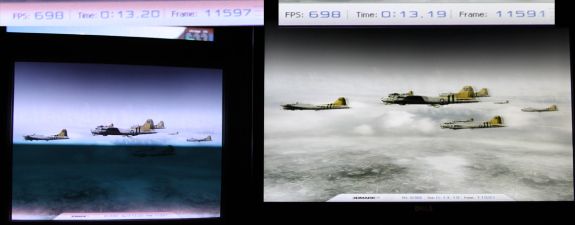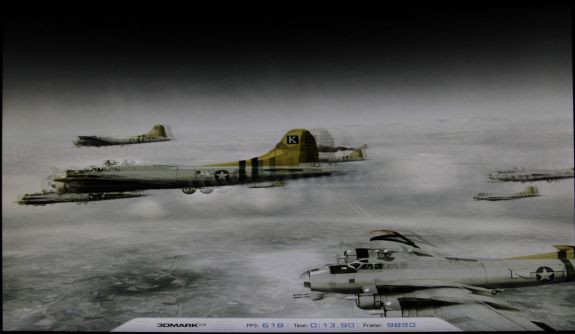Dell G2410H Review: A Green 24" LCD
by Brian Klug on May 7, 2010 1:43 AM EST
For gamers, display lag is a very real concern, and display processing is a nebulously reported (if at all) specification for just about all LCD displays. Ultimately, what matters isn’t GTG, full on, full off pixel response times, or what’s reported on the spec sheet, but the holistic latency of the monitor compared to something we can all agree is lag-free. In the past we’ve used the HP LP3065, which is an excellent baseline with almost no processing lag due to the absence of a hardware scaler, but we’re tweaking things around a bit (and yours truly doesn’t have said HP LCD), so we’re going to do something different.
One of the things we’ve seen requested pretty frequently is a comparison between the bonafide refresh rate of a good old CRT and LCD panels under test. I hopped into my time machine, took a trip to October 1999, and grabbed me a 17” Princeton EO700 CRT. This bad boy supports 1024x768 at a blistering 85 Hz. Oh, it also weighs a million pounds and makes weird sounds when turning on and off.
To do these tests, we connect the CRT up to a DVI to VGA adapter on our test computer’s ATI Radeon HD5870, and the LCD panel under test to DVI using an HDMI to DVI cable. I debated for some time the merits of using the same VGA signal, however, what really matters here is how the two display methods matter in the way that you, readers, are most likely to set things up. In addition, using the VGA input on any LCD is bound to add additional lag, as this is definitely a hardware scaler operation to go from analog to digital signaling, compared to the entirely digital DVI datapath. We run the CRT at 1024x768 and 85 Hz, its highest refresh rate, and clone the display to the LCD panel.
We use the same 3Dmark03 Wings of Fury benchmark on constant loop, take a bunch of photos with a fast camera (in this case, a Canon 7D with a 28-70mm F/2.8L) with wide open aperture for fast shutter speeds, in this case at 1/800 of a second. Any differences on the demo clock will be our processing lag, and we’ll still get a good feel for how much pixel response lag there is on the LCD.
The only downside is that this means our old data is no longer a valid reference.
To compute the processing lag, I do two things. First, I watch for differences in the clock between the CRT and LCD, noting these whenever they are visible. I did this for 10 captures of the same sequence. Second, one can compute the processing difference by taking into account the FPS and the frame number difference:
Of course, not every one of those frames is written to the display, but we can still glean how much time difference there is between these respective frames with much more precision than from averaging the time, which only reports down to 1/100ths of a second. An example shot of what this difference looks like is the following:
The G2410H is a pretty decent starting benchmark for our brave new test method, considering at its core is a relatively normal S-TN panel. This is largely in line with what we expected to see, and on the whole, the processing lag is very small at around 9 ms. We’ll get a feel as we add more monitors, but this is on the whole very interesting.
| Dell G2410H - Processing Lag | |||
| Averaging Time Difference | FPS Computation Time Difference | ||
| 9.0 ms | 8.59 m | ||
When it comes to actual pixel lag, we see with the G2410H what we usually see on all LCDs, one ghost image before and after the dominant frame, even at very fast shutter speeds so we’re not accidentally sampling the next. This still corresponds to roughly 16 ms. It’s interesting that the G2410H and other LCDs exhibit this ghosting.
At the end of the day, LCD performance still isn’t quite at parity with CRTs. But at the same time, I doubt anybody is going to want to borrow my time machine to buy one and replace their LCD. You’re getting a heck of a lot more screen real estate with a smaller, lighter weight footprint, for less electrical power, and you don’t have to look like a crazy doing it. Sure, there are a handful hardcore gamers out there that swear by their CRT’s faster refresh rate, but could a single one of them really discern individual pulses of a 9ms flashing strobe?














39 Comments
View All Comments
tno - Friday, May 7, 2010 - link
"unless you’re using an HDMI to DVI cable, you should be running the LCD at native resolution."I am currently using two HDMI to DVI cables in my HT set-up. HTPC (DVI) to receiver (HDMI) and receiver (HDMI) to old Sony XBR 1080i (DVI). This is all HDCP comliant so I don't have any issues. Since I'm moving very far away I will be leaving my tried and true Sony and in the interim between moving and getting a NEW TV I picked u a rather cheap OLD TV (Dell W3000). This older model does not have HDMI either so I will still be using an HDMI to DVI cable. Is this a bad thing?
I'm running at 720p out of the PC on this 13//x768 dislay? Will this be a problem? Should I set the PC to the native rez? Thanks for the article BTW. Great job. I have loved my CRTs, (the XBR plus a behemoth 2048x1536 NEC model for my PC) and hung to them more because of the bargains that they were. I gladly traded the exertion required to lift them for the cheap price and better PQ was just bonus. But the prospect of moving them has lessened their appeal so I will be tube free from now on.
tno
quiksilvr - Friday, May 7, 2010 - link
I'll state what I stated before when I commented on the release of the G2410 and heard about these "letdowns".Ahem...
If there are no speakers, WHY DO YOU NEED HDMI? It has HDCP compliant DVI-D. Just spend the whopping $5 and get the DVI-D to HDMI adapter. It's not like this thins is 2560x1400. Its a run of the mill 1080p screen.
aftlizard - Friday, May 7, 2010 - link
Why do I need HDMI if I don't need audio? Because I don't want to spend the extra money if I don't have to. If I have the cable already or want to spend money on the cable I can find hdmi cables cheaper than a converter or even an hdmi-dvi cable.aftlizard - Friday, May 7, 2010 - link
Why do I need HDMI if I don't need audio? Because I don't want to spend the extra money if I don't have to. If I have the cable already or want to spend money on the cable I can find hdmi cables cheaper than a converter or even an hdmi-dvi cable.james.jwb - Friday, May 7, 2010 - link
Next monitor upgrade: 24-inch or larger, IPS or better, 120 Hz performance.When that comes I'll be happy ;)
JarredWalton - Friday, May 7, 2010 - link
I don't know that anyone has done IPS (or PVA/MVA for that matter) at anything above 60Hz. I could be wrong, I freely admit this, but virtually every 120Hz display I've heard about was a TN panel. Blech. When you consider the pixel response times, though, it starts to make a bit of sense. 120Hz should be doable with the 6ms IPS panels, but the 2ms TN panels might switch a bit faster. (Note that in our testing, even the 2ms TN panels still show much 2-3 frames.)Anyway, I'm with you. I'd like 120Hz IPS, with a high resolution 30" panel. LOL. I think I'd need quad-link DVI to do that.
james.jwb - Friday, May 7, 2010 - link
display port should do it?svojoe - Friday, May 7, 2010 - link
for off griders like myself this is sooooo awesome. 13 watts! Holy crap thats such low power consumption I can not feel bad about draining down my batteries!Brian Klug - Saturday, May 8, 2010 - link
Out of curiosity, are you on a PV system or something else? I'm moving into a place that's entirely solar powered with a 1:1 PV offset. I'm glad there's someone out there excited by the prospect of a low-power monitor, I mean, 11 watts still is impressive to me as well. Especially considering the brightness you get for that amount of power.-Brian Klug
Porksmuggler - Saturday, May 8, 2010 - link
Thanks for putting the panel type TN on the first page. $339 for a TN with no HDMI, no thanks. The 1080P isn't puzzling at all, it's all about saving on panel cost. Anyone feel like doing the math on how long you would have to use this "green" LCD to make up for the sticker bloat?